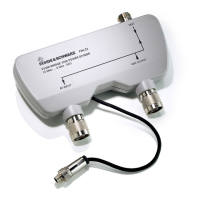R&S
®
CMW 500 WiMAX Applications
WiMAX GUI Reference
Operating Manual 1202.3986.32 – 03 378
Frequency
Center frequency of the RF analyzer. Set this frequency to the frequency of the
measured RF signal to obtain a meaningful measurement result.
GPIB command: CONFigure:WIMax:MEASurement<i>:RFSettings:FREQuency
Expected Nominal Power
Defines the nominal power of the RF signal to be measured. The nominal power is the
average output power at the DUT during the measurement intervals where the RF
transmitter is on. The "Ref. Level" is calculated as the expected peak power at the
output of the DUT:
Reference power = Expected Nominal Power + User Margin
Maximum input power
The actual input power at the connectors (i.e. the "Reference Level" minus the
"External Attenuation (Input)" value, if all power settings are configured correctly) must
be within the level range of the selected RF input connector; refer to the
"Specifications".
GPIB command: CONFigure:WIMax:MEASurement<i>:RFSettings:ENPower
User Margin
Margin that the R&S CMW 500 adds to the "Expected Nominal Power" in order to
determine its reference power; see above. The "User Margin" is typically used to
account for the known variations of the RF input signal power, e.g. the variations due
to a specific channel configuration.
For OFDMA signals, the appropriate values depend on the modulation scheme.
GPIB command: CONFigure:WIMax:MEASurement<i>:RFSettings:UMARgin
10.2.1.3 Multi Evaluation Configuration: Control
The "Control" parameters configure the scope of the measurement.
Multi evaluation configuration: scope
Control – Repetition
Defines how often the measurement is repeated if it is not stopped explicitly; see
Statistical Settings.
A "Continuous" measurement is continued until it is explicitly terminated; the
results are periodically updated.

